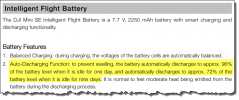When I received both my DJI Mini SE (FOR SALE) and my Mini 2, the batteries were in "hibernation" mode according to the instructions.
If I don't sell the SE shortly, I am going on holiday for a couple of months and I guess I should put the batteries back into hibernation mode so they don't discharge too much.
I found this statement in a DJI article about their batteries:
"The battery automatically discharges to below 65% when it is idle for more than 10 days to prevent it from swelling. It takes approximately 3 days to discharge the battery to 65%. It is normal that you may feel moderate heat emitting from the battery during the discharge process. Set the discharging thresholds in the DJI GO app."
I can't find anything about discharging/hibernating the Mini batteries in the Fly app???
If I don't sell the SE shortly, I am going on holiday for a couple of months and I guess I should put the batteries back into hibernation mode so they don't discharge too much.
I found this statement in a DJI article about their batteries:
"The battery automatically discharges to below 65% when it is idle for more than 10 days to prevent it from swelling. It takes approximately 3 days to discharge the battery to 65%. It is normal that you may feel moderate heat emitting from the battery during the discharge process. Set the discharging thresholds in the DJI GO app."
I can't find anything about discharging/hibernating the Mini batteries in the Fly app???
Last edited:












